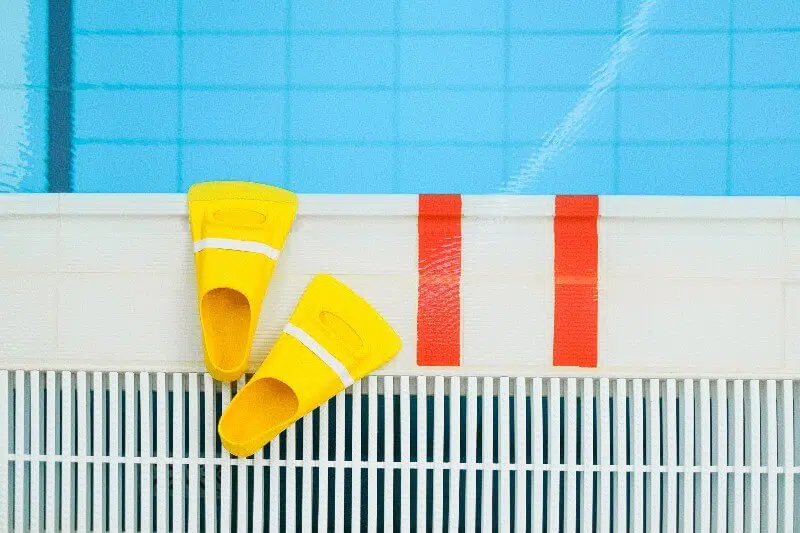Swimming with fins is not as easy as you may think. The goal is you focus on your leg movements, to adopt a best technique.
Swimming with fins allows you to strengthen lower body muscles as well as your endurance. But that's not all, its advantages are numerous!
Why swim with fins?
Swimming with fins is ideal for improving the different technical aspects of your swimming. But it is also a very good way to tone your figure.
Fins for better swimming technique
You are focused on your movements
With fins on your feet, you concentrate more on your movements. In particular the kick and the leg kicks.
You can then perfect these movements to better reproduce them once the fins are removed.
You adopt a better swimming position
Fins add additional water resistance. This pushes you to have best supports and one best sheathing of the abs and lumbar.
Without realizing it, you will then adopt a best position swimming and a better balance.
Your shoulders are relieved
When swimming with fins, your legs are used more than your upper body. They are what move you forward, more than your arms.
Result ? Your shoulders are then (relatively) less engaged, because they have less tension to support.
Your lengths are more pleasant
Swimming with fins offers better sliding sensation. YOU swim faster and you feel better in the water.
This makes your lengths more fun And more pleasant. You can then easily vary your swimming sessions!
Fins to strengthen and tone your muscles
You work your muscles in depth
With fins you have more resistance, which requires more effort And strains your muscles even more (legs, glutes, abs, etc.).
Swimming with fins will above all strengthen all the lower body muscles, but also your ankles. They will gain in mobility and flexibility.
You strengthen your endurance
Swimming with fins will allow to increase the cadence of your leg kicks. The higher your cadence, the more your cardio work.
This is a great way to improve your cardiovascular endurance, but also your muscular endurance.
You tone your figure
Swimming with fins allows you to burn even more calories than without fins.
So if you adopt a good Alimentation, you go tone And refine Your figure !
You eliminate cellulite
Thanks to the massaging effect And draining of the water, you eliminate cellulite. The faster you swim, the more powerful drainage the water will provide.
Additionally, swimming with fins will also promote your blood circulation and help you avoid the feeling of heavy legs.
Don’t get too used to it either…
Yes, swimming with fins is very pleasant and very pleasant, but think about varying. By always using fins, your “natural” swimming will no longer be familiar to you.
Additionally, using them too often you can also have light bulbs. So, don't hesitate to take them off and swim without them!
What are the different types of fins?
According to your practical (swimming, diving, etc.), fins are not not the same. There are different sizes, canopies, etc.
Swimming fins
They are quite short to allow you to keep a beat frequency legs similar to swimming without fins.
Their size is also designed to minimally disturb other swimmers.
Snorkeling fins
To discover the seabed, you use fins light and relatively short. Less than those for swimming, but more than those for diving.
The sail is enough flexible and the comfortable slipper to allow you to swim in the sea for a long time.
Freediving fins
They are made of a sail long And rigid which allows you to have wider movements. So you will faster.
Freediving fins are often made up of a carbon sail which brings more lightness and of propulsion.
Scuba diving fins
They are often fins footwear, enough long, which offer a good maintenance at the foot level.
They are long to allow you to move quickly without too much effort, to avoid consuming too much energy and air.
How to choose your fins?
You understand, there is different types of fins, but those that interest us most are those of swimming.
To choose the right swimming fins, different criteria must be taken into account:
- THE heel/footwear
- There length
- There sail
Regarding the size, we advise you to take a size above, because your feet are likely to swell a little during exercise.
The heel/foot of your fins
There are two types of heels:
- THE closed heel, Who surrounds the entire lower part of the foot and the heel, for more stability.
- THE open heel, which leaves the exposed lower heel, to give more amplitude at your ankle.
The flippers closed heel are usually footwear, they adapt to your foot without having to tighten or adjust your fins.
THE open heel fins are they sometimes adjustable with straps. We advise you to put them with a neoprene liner to avoid heel pain.
The length of your fins
It is especially this criterion which will play on the technical and the swimming speed.
Short fins
They do not exceed 15 cm in order to allow you to have a good beat frequency.
They allow you to coordinate your movements well and work on your kick.
They are ideal for work on your cardiovascular endurance and work on your abs, glutes and legs.
Short fins are mainly made for swim in pool.
Long fins
They easily exceed 15 cm, which makes the slower movements, but more powerful. You move quickly with long fins.
They allow better gliding in, and on, water, while putting more strain on your muscles. They are ideal for work on the waves.
Long fins are mainly made for diving and the long distance open water swimming.
The rigidity of the sail
Soft-fin fins
The more your fins are flexible, the more they are easy to handle. There is less resistance, which requires less effort. Soft fins are often used for work on the speed of the beats.
Rigid wing fins
The more your fins are rigid, the more you go work the muscles of your legs. You will go faster, but your legs will provide a lot of effort to be able to make them move.
To choose your fins carefully, you must adapt to your practice : diving, swimming, snorkeling, etc.
Depending on your activity, choose fins with an appropriate blade, size and heel.
How to use your fins properly?
Now that you know how to make the right choice, it's just as important to know how to use them properly.
Here are some tips that will be useful to you:
- Always think well of yourself warm up before swimming.
- Try to keep the relaxed body, especially the ankles.
- Consider having the legs almost straight all along.
- For beginners, use small flippers to get used to it.
- THE beat of legs must from your hips.
- Try to make ample and fluid beats.
- There rise of the movement is also important than the descent.
- Adopt a short and quick kick by stretching your toes.
To apply these tips during your swimming sessions with fins, we advise you to carry out some exercises.
4 exercises to try with your fins
1. Kicks with a plank
Put on your swimming fins and take with you a plank. This exercise will help you improve your leg kicks targeting your abs, glutes and legs.
Once in the water, position yourself as if you were going to swim the front crawl. Extend your arms in front of you while holding the plank. Your fins should be underwater, at the edge of the surface.
Then you just have to perform leg kicks To advance. Concentrate on the movement by moving the whole leg from your hip.
You can also try this exercise backstroke, with or without the board.
2. Waves (with or without a board)
Put your flippers and jump into the water. This exercise will mainly solicit your abs sheathing, of the lumbar, but also your legs.
As for the previous exercise, extend your arms in front of you, but this time, place your hands on top of each other. Keep your head in a neutral position, underwater, and put your feet together.
Once in position, perform waves that start from the bust up to the ankles. The undulations are pelvis movements from top to bottom. keep them legs stretched and flexible to accompany your pool.
If you have a little difficulty performing the exercise, you can take a board and hold it out in front of you as for the first exercise.
3. Sideways Waves (with or without a plank)
This exercise will mainly target the muscles of the abs, of the legs and glutes. To achieve it, you only need your flippers. Once in the water, stand aside.
If you are on the right side, extend your right arm And lay your head on it. It must be in the water and your gaze should be directed to the sides of the pelvis. To breathe, turn your head toward the ceiling.
With the left arm alongside the body, perform undulating movements while remaining on the side. Alternate by changing sides as you go along the lengths.
If you feel that the exercise is difficult, you can place a board under your head.
4. Vertical waves
With this exercise, you will mainly strain the abdominal strap and the lumbar. You are going to do on the spot trying to stand up straight in the water.
Dive into the water and stand vertically. You can keep your arms alongside your body as long as you do not use them to float during the exercise.
keep them grouped feet and make undulations with your legs and your basin in order to stay on the surface. The goal is to keep the body straight, stable And sheath. Stand taller so your shoulders stay above water.
Conclusion
Swimming with fins allows you to create more resistance and of burn more calories. It's also a good way to make your sessions swimming more fun and put less pressure on the upper body.
It exists different types of fins, but for swim in pool, the most suitable are the short fins. So, buy a pair of fins and take to the water to improve your technique and tone your figure!
What if you tried aquapalming?
Do you want to do something other than swim with fins? SO aqua palming is made for you !
At Aqua by we suggest you use flippers and others accessories during classes aqua palming.
Our aquapalming classes are inspired by different aquagym movements, but by adding resistance thanks to the fins and various accessories.
So, if you want to try, book your aquapalming course in one of our Parisian studios, or in Boulogne, and join us!
Swimming with fins is good, but without fins what does it mean?
It is true that swimming with fins has many advantages. But don't worry, there is different exercises that use the same muscles.
To find out more, take a look at our article on THE different exercises to do in the pool.





